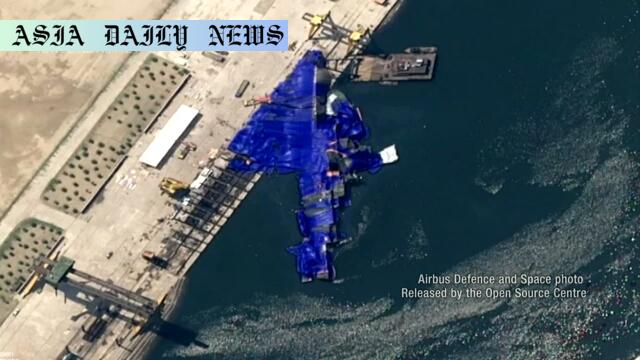Warship Launch: North Korea blamed a failed warship launch on three officials, including the chief engineer, detaining them for negligence.
North Korea detained three officials following a key warship launch failure.
A 5,000-ton destroyer was partially submerged after stability issues at launch.
Leader Kim Jong Un ordered timely restoration before a major party meeting.
The incident adds to scrutiny on North Korea’s technological capabilities.

Warship Launch Blunder: Accountability in North Korea
The recent incident involving North Korea’s attempt to launch a 5,000-ton warship ended in failure and has placed the spotlight on the nation’s defense sector. According to the Rodong Sinmun, the ruling Workers’ Party newspaper, three officials have been detained, including the chief engineer of the shipyard, for their alleged role in the mishap. The vessel, which was covered in blue tarps and extensively captured via satellite imagery, was seen lying on its side, partially submerged on the shipway. The root cause of the failure was attributed to the bow of the ship failing to detach during the launch, leading to an imbalance and subsequent submergence.
Repair and Leadership’s Immediate Response
Despite the setback, North Korean leadership, including Kim Jong Un, has actively addressed the issue by prioritizing swift repairs. Kim has set a goal to restore the damaged destroyer before the party’s Central Committee plenary meeting, scheduled for late June. Officials have emphasized that no additional damage has occurred to the warship, and operations are progressing as planned. While the newspaper has reassured the public about the repair schedule, the detention of officials signals a strong stance from the leadership – a move likely aimed at maintaining accountability and as a deterrent for future errors.
Technological Implications and Broader Significance
This incident resonates beyond the immediate mishap, as it raises questions regarding North Korea’s technological capabilities in defense. The failure not only delays the country’s strategic objectives in terms of enhancing naval firepower but also signals vulnerabilities in the shipbuilding sector. With sanctions limiting access to key resources and technologies, the pressure on local industries to deliver successful projects remains immense. This failure also affects North Korea’s credibility on the international stage, where such incidents are closely monitored for signs of progress or deterioration in its military advancements.
Global Concerns Around North Korea’s Actions
The failed warship launch and subsequent detentions underscore both the political and operational challenges facing North Korea. Beyond the borders of the nation, it is understood that any advancements in maritime defense could have broader consequences, especially for nations in the region. While the mishap may temporarily delay North Korea’s ambitions, its persistence in pursuing military advancements remains clear. This determination continues to concern neighboring countries such as South Korea and Japan, as well as international entities like the United Nations.
The Human Element – Accountability and Risks
Finally, this incident sheds light on the human element behind ambitious state projects in regimes like North Korea. The detention of officials demonstrates the high stakes and risks involved for individuals tasked with executing such objectives. It also reflects North Korea’s tendency to place blame squarely on individuals rather than systemic issues within the state apparatus. Whether true accountability or fear tactics, such actions have significant implications for the workforce within the nation’s defense sector.



Commentary
A Leadership Style Focused on Accountability
North Korea’s swift response to the failed warship launch highlights a leadership approach that prioritizes accountability, albeit in ways that might appear extreme to the outside world. The detention of the chief engineer and related officials indicates a clear message being sent to others involved in similar high-stakes projects: failure comes with severe consequences. This approach, while effective in instilling discipline, brings into question the human rights and morale of those tasked with overcoming immense challenges in a resource-strapped environment.
Implications for North Korea’s Military Image
The warship launch mishap has also spotlighted the vulnerabilities within North Korea’s military-industrial complex. For a country that often uses demonstrations of military strength to project power, the incident undermines parts of that narrative. Repair efforts may eventually salvage the project, but the damage to North Korea’s reputation – both domestically and internationally – cannot be ignored. This incident becomes a point of analysis for countries keeping a close eye on the nation’s military capabilities.
Balancing Ambition with Realism
While ambition drives North Korea’s military strategies, incidents like these should serve as reminders of the importance of balancing aspirations with practical realities. Resource limitations, sanctions, and restrictions on critical technologies create an environment fraught with obstacles. Achieving military milestones under such conditions requires robust planning, sufficient testing, and addressing systemic weaknesses. Focusing on these areas could help North Korea avoid similar failures in the future.
Reflections on the Broader Context
In the broader geopolitical context, this event is a microcosm of North Korea’s ongoing struggles between projecting power and dealing with the real limitations it faces. While the international community keeps a watchful eye, every failure or success becomes a measure of the country’s trajectory. Ultimately, how North Korea learns from this incident – whether through structural improvements or surface-level blame games – will shape its future endeavors in military development and its standing in the global arena.